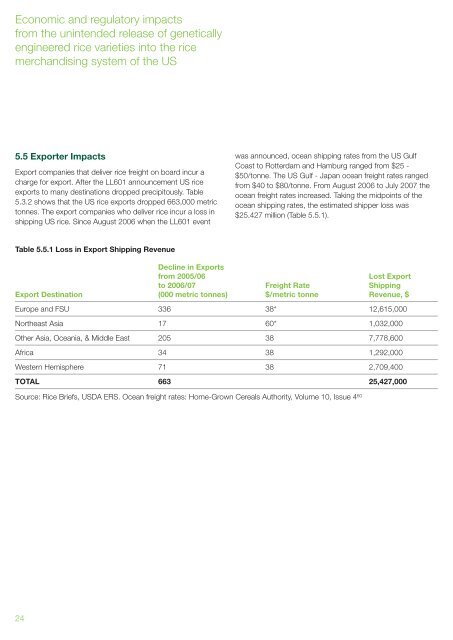Risky Business - Greenpeace
Risky Business - Greenpeace
Risky Business - Greenpeace
You also want an ePaper? Increase the reach of your titles
YUMPU automatically turns print PDFs into web optimized ePapers that Google loves.
Economic and regulatory impacts<br />
from the unintended release of genetically<br />
engineered rice varieties into the rice<br />
merchandising system of the US<br />
5.5 Exporter Impacts<br />
Export companies that deliver rice freight on board incur a<br />
charge for export. After the LL601 announcement US rice<br />
exports to many destinations dropped precipitously. Table<br />
5.3.2 shows that the US rice exports dropped 663,000 metric<br />
tonnes. The export companies who deliver rice incur a loss in<br />
shipping US rice. Since August 2006 when the LL601 event<br />
was announced, ocean shipping rates from the US Gulf<br />
Coast to Rotterdam and Hamburg ranged from $25 -<br />
$50/tonne. The US Gulf - Japan ocean freight rates ranged<br />
from $40 to $80/tonne. From August 2006 to July 2007 the<br />
ocean freight rates increased. Taking the midpoints of the<br />
ocean shipping rates, the estimated shipper loss was<br />
$25.427 million (Table 5.5.1).<br />
Table 5.5.1 Loss in Export Shipping Revenue<br />
Decline in Exports<br />
from 2005/06<br />
Lost Export<br />
to 2006/07 Freight Rate Shipping<br />
Export Destination (000 metric tonnes) $/metric tonne Revenue, $<br />
Europe and FSU 336 38* 12,615,000<br />
Northeast Asia 17 60* 1,032,000<br />
Other Asia, Oceania, & Middle East 205 38 7,778,600<br />
Africa 34 38 1,292,000<br />
Western Hemisphere 71 38 2,709,400<br />
TOTAL 663 25,427,000<br />
Source: Rice Briefs, USDA ERS. Ocean freight rates: Home-Grown Cereals Authority, Volume 10, Issue 4 60<br />
24

















